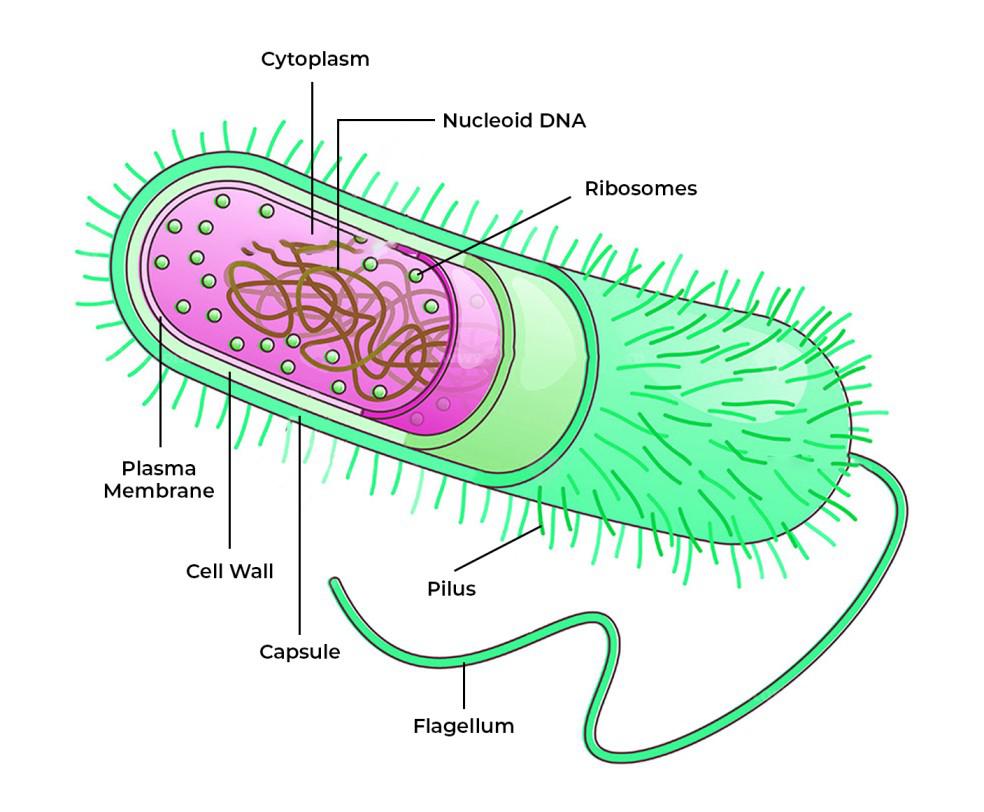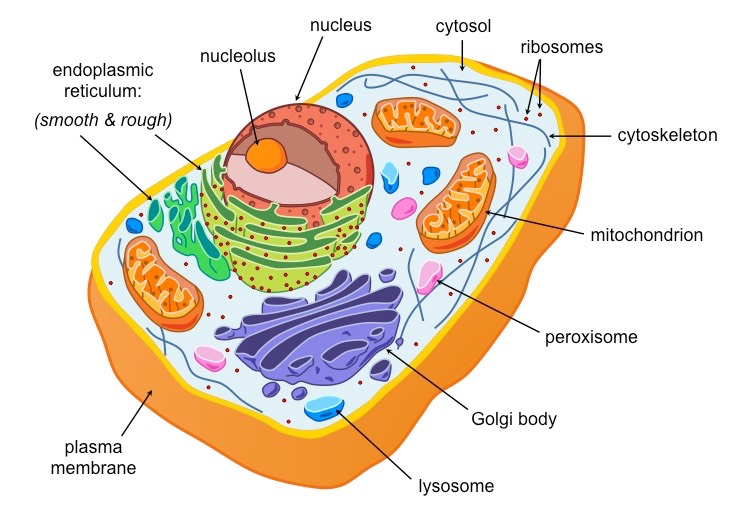Table of Contents
The living parts of nature, like tiny bacteria and huge Sequoia trees, make up the biotic environment. Even though all living things are made of cells, which are like the building blocks of life, they come in various shapes and sizes.
So, we call the cell the basic unit that makes everything alive work. The word “cell” comes from Latin, and it means a “small room.” A long time ago, in 1665, an English scientist named Robert Hooke saw cells for the first time. He thought they looked like the cells in a honeycomb.
As time went on, scientists learned more and more about cells and how they’re built. In the 1950s, they figured out that there are two main types of cells: prokaryotic and eukaryotic cells. A French biologist named Edouard Chatton started this idea back in 1925. These cells are different in how they’re put together, and we’ll explore those differences next.

Prokaryotic Cell
The term “prokaryote” originates from the Greek words “pro” (meaning: before) and “karyon” (meaning: kernel), signifying “before nuclei.” Prokaryotes are among the oldest known life forms on Earth, with fossil evidence dating back approximately 3.5 billion years.
In the ancient Earth environment, these prokaryotes thrived, some utilizing chemical energy while others harnessed solar energy. Over millions of years, these extremophiles adapted and evolved, and there is a scientific hypothesis suggesting they may have contributed to the development of eukaryotic organisms.
Prokaryotic cells are notably smaller and simpler compared to eukaryotic cells. They lack membrane-bound organelles such as a nucleus and reproduce through binary fission.
Structurally, prokaryotes possess a protective capsule enveloping their entire body to defend against phagocytosis, where other eukaryotic cells like macrophages engulf them. They also have hair-like appendages called pili, aiding attachment to various surfaces, and a cell wall providing strength. The cytoplasm lies beneath the protective coating, supporting cellular growth, and is enclosed by the plasma membrane, which separates the cell’s interior from the external environment. Ribosomes in the cytoplasm play a crucial role in protein synthesis.
Some prokaryotic cells have mesosomes for cellular respiration and plasmids, small circular DNA pieces. Flagella and pili aid in locomotion. Common examples of prokaryotic organisms include bacteria and archaea. All members of the Kingdom Monera belong to the prokaryotic category.
Prokaryotic Cell Diagram

Examples of Prokaryotic Cell
Here are some examples of prokaryotic cells:
Bacterial Cells
- Bacteria are tiny, single-celled creatures that can be found everywhere, from soil to our bodies.
- They come in various shapes and sizes.
- Bacterial cell walls are made of a substance called peptidoglycan, which gives them structure.
- Bacteria have unique parts like pili, flagella (tail-like structures for movement), and capsules.
- They also have extra bits of DNA called plasmids.
- Bacteria can form tough, dormant structures called endospores, which help them survive when conditions are bad. These endospores wake up when conditions get better.
Archaeal Cells
- Archaea are similar to bacteria in size and shape and are also single-celled organisms.
- They live in extreme places like hot springs and can be found in soil, marshes, and even inside our bodies.
- Archaeal cells have cell walls and flagella too, but their cell walls don’t contain peptidoglycan.
- The membranes of archaeal cells have different types of fats with a unique structure.
- Like bacteria, archaea have a single circular chromosome and can also have plasmids.
Eukaryotic Cell Definition
The term “Eukaryotes” comes from Greek, where “eu” means good and “karyon” means kernel, so it translates to “good or true nuclei.” Eukaryotes are more complex and bigger than prokaryotes. They make up most of the major groups of life, except for the monera kingdom.
Eukaryotes have a cell wall that supports and protects the cell’s outer layer, called the plasma membrane. This membrane controls what goes in and out of the cell.
Inside the cell, there’s a nucleus that holds DNA, which stores all the genetic information. The nucleus is surrounded by a protective layer called the nuclear membrane. Inside the nucleus, there’s a part called the nucleolus, which helps make proteins. Eukaryotic Cells also have mitochondria that make energy for the cell to use.
In plant cells, there are chloroplasts that do photosynthesis. The endoplasmic reticulum helps move materials around the cell. There are other cell parts too, like ribosomes, lysosomes, Golgi bodies, cytoplasm, chromosomes, vacuoles, and centrosomes, each with its own job.
Almost all single-celled organisms with a nucleus and all multi-celled organisms are examples of eukaryotes.
Eukaryotic Cell Diagram

Examples of Eukaryotic Cells
Eukaryotic cells can be found in plants, animals, fungi, protozoa, and other complex living things. Let’s look at some examples of these eukaryotic cells:
- Plant Cells: Plant cells have a sturdy outer layer called the cell wall, made of a substance called cellulose. This cell wall provides support to the plant. Inside the plant cell, there’s a big storage space called the vacuole, which helps maintain the cell’s shape. Plant cells also contain chloroplasts, which play a crucial role in the process of photosynthesis.
- Fungal Cells: Fungal cells have a cell wall too, but it’s made of something called chitin. Some fungi have tiny holes called septa that allow organelles and cytoplasm to move within the cell.
- Animal Cells: Unlike plant and fungal cells, animal cells don’t have a cell wall. Instead, they are surrounded by a flexible cell membrane. This lack of a rigid cell wall gives animals the ability to have various shapes. Animal cells also have special abilities like phagocytosis (engulfing food particles) and pinocytosis (engulfing liquid).
- Protozoa: Protozoa are tiny, single-celled organisms. Some of them have tiny hair-like structures called cilia that help them move around. They also have a thin layer called a pellicle that supports their cell structure.
Difference between Prokaryotic and Eukaryotic Cell
While prokaryotic and eukaryotic cells have some similarities, such as having cell membranes and ribosomes, they also have many differences. Here’s a summary of the differences between prokaryotic and Eukaryotic cells:
| Prokaryotes | Eukaryotes | |
| Type of Cell | Always unicellular | Unicellular and multi-cellular |
| Cell size | Ranges in size from 0.2 μm – 2.0 μm in diameter | Size ranges from 10 μm – 100 μm in diameter |
| Cell wall | Usually present; chemically complex in nature | When present, chemically simple in nature |
| Nucleus | Absent. Instead, they have a nucleoid region in the cell | Present |
| Ribosomes | Present. Smaller in size and spherical in shape | Present. Comparatively larger in size and linear in shape |
| DNA arrangement | Circular | Linear |
| Mitochondria | Absent | Present |
| Cytoplasm | Present, but cell organelles absent | Present, cell organelles present |
| Endoplasmic reticulum | Absent | Present |
| Plasmids | Present | Very rarely found in eukaryotes |
| Ribosome | Small ribosomes | Large ribosomes |
| Lysosome | Lysosomes and centrosomes are absent | Lysosomes and centrosomes are present |
| Cell division | Through binary fission | Through mitosis |
| Flagella | The flagella are smaller in size | The flagella are larger in size |
| Reproduction | Asexual | Both asexual and sexual |
| Example | Bacteria and Archaea | Plant and Animal cell |
FAQs on Difference Between Prokaryotic and Eukaryotic Cells
What is a Prokaryotic cell?
A prokaryotic cell is a simple kind of cell that doesn't have a nucleus. Also, prokaryotes don't have special compartments with membranes inside their cells. Prokaryotes are always just one cell.
What is a Eukaryotic cell?
Eukaryotic cells are cells that have a central control center called a nucleus and small compartments surrounded by membranes inside them. These cells can exist as single-celled or multi-celled organisms.
What is the difference between Prokaryotic and Eukaryotic cells?
The key difference that sets apart prokaryotic cells from eukaryotic cells is the nucleus. Prokaryotic cells don't have a true nucleus, and eukaryotic cells do have one. Additionally, eukaryotic cells are the ones with tiny compartments enclosed by membranes, while prokaryotic cells lack these. Another big distinction is that prokaryotic cells are alway
Is Golgi apparatus prokaryotic or eukaryotic?
Golgi Appratus is Eukaryotic Cell.








